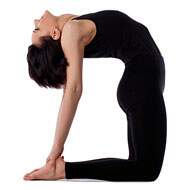Back-bend Poses
Back bends include most of the yogic poses that require you to arch your spine. Unlike forward bends - the other school of spine related poses, back bends are not postures we normally assume during the course of our daily routine.
In other words, we are a lot more prone to bending our spine forwards rather than backwards when carrying out simple everyday tasks.
This is why yogic back-bend poses are a lot more rewarding than forward bends. Back-bend poses are generally the hardest of all the yoga poses because they require the muscles, which support your spine, to be flexible and limber.
The idea of performing back bends is to open up the front of our bodies. Society favors people who are confident and outgoing. Greeting people involves looking at them right in the eye and grasping their hand in yours. Slouching and drooping generally gets a negative reaction from people.
Back bend yoga poses aim to stretch out your upper body, and at the same time tone muscles of the limbs and the hips. Stretching out the joints helps to warm them up in anticipation of the use we put them to, thereby sparing us some of those niggling pains and aches.
How Do I start off?
The correct procedure when embarking on back bend poses is to first start off with a couple of warm up poses. You can indulge in any of those poses that open up the shoulders and the hips. It is always the norm to start off a session of backbends with gentle yoga poses that do not tax the spine a lot, slowly progressing to the ones which require you to arch your spine a fair bit. Always remember to rest after performing a back bend pose. In addition, another IMPORTANT tip is to get the spine to its neutral position after every back bend pose by performing a "Downward Dog".
Cautions
Performing yoga based back bend poses can be quite exhilarating. There have been cases of people suffering from insomnia after a session of back bends. Backbends are intense and may be risky if performed without the guidance of an experienced teacher.
It doesn’t matter if you cannot bend all the way back in any of the back bend yoga poses. You must stretch only as far as it is comfortable for you.
Here is a list of a few foundational back-bending yoga poses in increasing order of difficulty,
- The Sphinx Pose - This is an ideal pose to start off your back-bending yoga session. It is light and gentle and is great for warming up.
- The Cobra Pose (Bhujangasana) - This pose is a natural progression from the "Sphinx pose". This pose, like all back bend poses, strengthens the spine and opens up the chest and the abdomen.
- The Locust Pose - This pose is another one of the beginner back bending yoga postures, bracketed with the “Bow Pose” and the "Sphinx Pose".
- The Upwards Facing Dog Pose – This pose is as common as the Downwards Facing Dog, and is great for stretching out your shoulders and thighs. When performing this pose remember not to subject your lower back to any excessive stress.
- The Camel Pose (Ustrasana) – There are two variations associated with this pose – The "Half Camel" Pose & the "Full Camel" Pose. This posture aims at improving posture and strengthening the muscles of the back.
- The Bridge Pose (Setu Bandha Sarvangasana) - This pose is ideal for women as it targets the uterus, and helps relieve the symptoms of menopause.
- The Pigeon Pose - Our hips tend to be wound up because we use them a lot in the course of our daily activities. This pose helps to unwind and stretch them out.
- The Bow Pose – This particular pose is called so because the body takes the figure of a bow when it is properly executed. It is a fairly advanced pose, and may require the guidance of an instructor when carried out for the first time.



